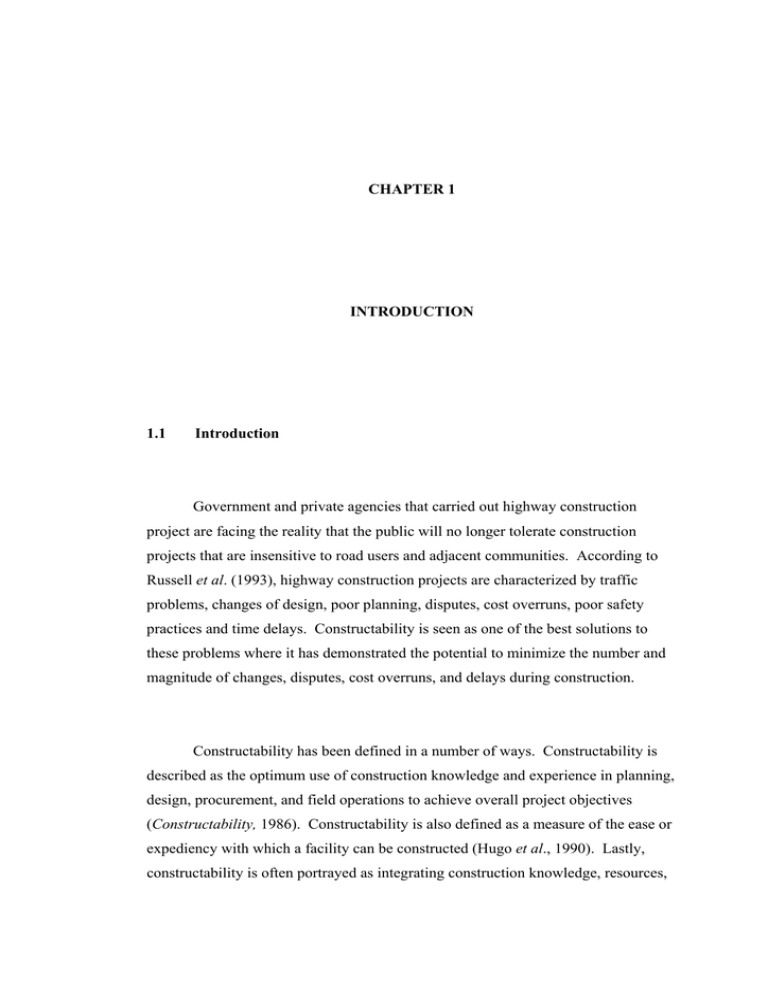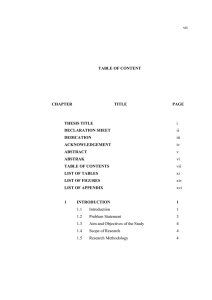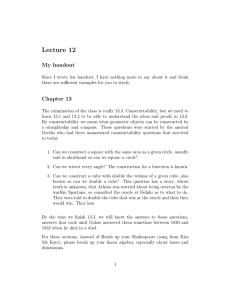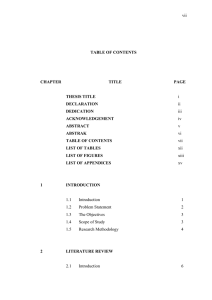CHAPTER 1 INTRODUCTION 1.1 Introduction
advertisement

CHAPTER 1 INTRODUCTION 1.1 Introduction Government and private agencies that carried out highway construction project are facing the reality that the public will no longer tolerate construction projects that are insensitive to road users and adjacent communities. According to Russell et al. (1993), highway construction projects are characterized by traffic problems, changes of design, poor planning, disputes, cost overruns, poor safety practices and time delays. Constructability is seen as one of the best solutions to these problems where it has demonstrated the potential to minimize the number and magnitude of changes, disputes, cost overruns, and delays during construction. Constructability has been defined in a number of ways. Constructability is described as the optimum use of construction knowledge and experience in planning, design, procurement, and field operations to achieve overall project objectives (Constructability, 1986). Constructability is also defined as a measure of the ease or expediency with which a facility can be constructed (Hugo et al., 1990). Lastly, constructability is often portrayed as integrating construction knowledge, resources, 2 technology and experience into the engineering and design of a project (Anderson et al., 1995). Highway project constructability can be particularly demanding for a range of reasons. For example, some of the highway construction technologies are varying hastily, and, as with most construction, the personnel is transient and site conditions can vary to the highest degree. Nearly all projects are subjected to severe public scrutiny involving open competitive bidding, thereby separating the planning and execution phases and largely precluding a fast-tracked approach to construction. Designs standards, authored by a multitude of organizations abound and often limit, if not discourage selective innovation. The prerequisite for nonproprietary specifications often leads to vagueness. In general, the perception is that project durations are longer than necessary and that construction costs can possibly be lowered. As a result, specifications supportive of constructability become an important element for improving project performance (Hugo et al., 1990). Beside the project performance, constructability also has been successfully used to reduce project durations. Eldin (1996) provides several examples of projects that have successfully used constructability to reduce project durations without increasing project cost. In a CII (1995) study five projects were analyzed, reporting 11 to 30% reductions in project duration directly attributed to constructability reviews (i.e., without cost increases). Although the majority of the projects were associated with industrial facilities, one of them was an interstate highway realignment that included the reconfiguration of eight bridges and the construction of two new bridges to facilitate the addition of a high occupancy vehicle lane in each direction (Eldin, 1996). Constructability review is the phase of construction project management where an independent and detailed analysis of all the contract drawings and construction documents is conducted before their release for construction. An effective constructability review process has the potential to incorporate into design 3 documents the best practices, guidelines, checklist, and lessons learned from previous projects, thereby improving the ease of construction and reducing life cycle costs. This critical process evaluates the “ability to construct” your construction project (Milstead, 1997). Constructability reviews of highway projects during design have the potential to minimize the number and magnitude of changes and delays during construction and thereby reduce durations (Anderson and Fisher 1997). A constructability analysis of six highway projects suggests that benefits may be as large as 25 times greater as costs (Anderson and Fisher 1997). Improved processes and management for effectively using constructability reviews to reduce total project durations can potentially improve construction project management. The way how to provide the best constructability review is by improving the understanding of application and importance of constructability concepts in highway projects. 1.2 Problem Statement Nowadays, highway construction suffers from lack of constructability, which causes traffic problems, changes of design, poor planning, disputes, cost overruns, poor safety practices and time delays. Researchers in developed countries have realized the seriousness of this shortfall and suggested solutions to resolve it. In Malaysia, research in constructability in highway projects has not been popular researched yet. One of the reasons is due to lack of understanding of constructability concepts among the engineers. Design Phase Constructability Improvement Concepts for Malaysian Highway Projects should be developed, that are aimed at encouraging the project team to apply them, where appropriate, to their projects. The basic message is that applying these constructability concepts will enhance project’s constructability, consequently optimizing the schedule, cost and quality of the project for the benefit of all parties involved. 4 1.3 Aim and Objectives of The Study The aim of this study is to establish Design Phase Constructability Guidelines For Highway Projects in Malaysian Construction Industry. In order to achieve it, the following objectives have been identified: a) To identify the constructability concepts in highway projects. b) To identify the level of importance and application of constructability concepts in highway projects. c) To establish Design Phase Constructability Improvement Guidelines for highway projects. 1.4 Scope of Research This research was carried out by questionnaires and interviews. The research focused on Malaysian Highway Projects with contract values of more than RM 5 million. The questionnaires were distributed to the senior construction management team like engineers, architect or project manager and etc, who involved in highway projects. 1.5 Research Methodology The methodology of research were help to realize the essential stages of methodology performed or steps of process carried in order to achieve the objectives 5 of this research. Figure 1.1 shows the research methodology chart that has been used in this research. CONCEPTUALIZATION • Phase 1 Design phase constructability concepts in highway projects LITERATURE REVIEW QUESTIONNAIRE SURVEYS • • DATA ANALYSIS Phase 2 Level of importance and application of constructability concepts Design Phase Constructability Improvement Guidelines for highway projects. CONCLUSION/ RECOMMENDATION Figure 1.1 Research Methodology Chart



